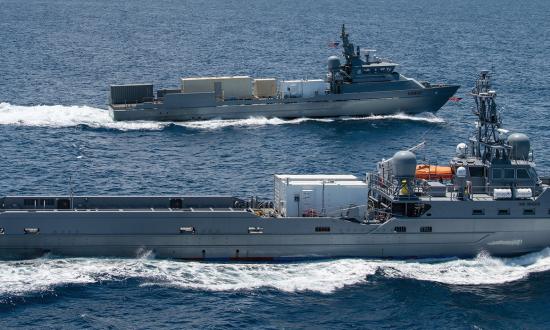Huntington Ingalls Shipbuilding delivered the Fort Lauderdale (LPD-28), the 12th San Antonio- class amphibious transport dock, in March. That ship and the under-construction LPD-29 are transitioning the class to Flight II, of which the Navy wants 13 ships, for a total of 26 LPDs. The ship’s development tells an important tale of Navy shipbuilding—both big successes and frustrating setbacks.
Displacing about 25,000 tons, the 684-foot-long San Antonios each have a flight deck and hangar to accommodate two CH-53E heavy-lift helicopters, two V-22 tiltrotors, or four combat helicopter gunships. The ships’ well decks can launch two large landing craft. An innovative enclosed mast houses nearly all the ships’ antennas. Each can accommodate up to 800 Marines, and it is the first class in the Navy to provide women-only spaces from the keel up.
The class’s history—some of it now almost ancient—is worth reviewing. Around 1990, the Navy faced a “block obsolescence” created by the impending retirement of four amphib classes—Austin, Anchorage, Charleston, and Newport—manned by around 13,000 sailors. In November 1990, the Joint Requirements Oversight Council approved a mission needs statement for a single replacement class: LX. After a series of feasibility studies and internal reviews, in 1993 Naval Sea Systems Command (NavSea) started preliminary design work on the planned 11-ship class, aiming to field the first ship by 2000. The Navy expected it would employ the highest of high-tech weapon and engineering systems, reducing manning to about 5,200 for all the ships—a huge saving.
In 1995, LX became LPD-17, with delivery set for 2004. The first program manager, Captain M. A. Gauthier, said LPD-17 would be the “most capable amphibious ship ever built.” The San Antonio program helped pioneer the introduction of commercial computer technology to replace expensive Navy- unique computers. A huge innovation, Gauthier said, would be its ship-wide area network (SWAN)—three fiber-optic networks linking machinery, damage control, and combat systems to provide the commander with real-time information on total-ship operations.
In mid-1997, the program became a kind of guinea pig for new management practices to hash out design concepts. The Expeditionary Warfare Integrated Product Team, or “Team 17,” included people from OPNAV’s Expeditionary Warfare Division, NavSea’s amphibious ship office, Marine Corps Systems Command, Marine Forces Atlantic and Pacific, several Navy labs, experts from Hughes (now Raytheon), and General Dynamics Bath Iron Works. The team communicated via a “digital product data environment” developed by Intergraph.
The Navy awarded the shipbuilding contract to Avondale Shipyards in December 1996, but Litton Ingalls immediately protested the award, delaying the start of construction. Litton and Avondale then merged, before Northrop Grumman acquired Litton Avondale The San Antonio's keel was laid in 2000, and the ship was launched in 2003—but with problems so severe, she had to be towed from a shipyard near New Orleans to another in Pascagoula, Mississippi.
In May 2005, the program was around $800 million over budget. Hurricane Katrina in August 2005 added to the problems for the San Antonio and the next four ships, the New Orleans, Mesa Verde, Green Bay, and New York (LPDs- 18 through -21). DoD and Navy auditors reported persistent problems with the SWAN, engines, and weapon systems.
In 2008, the Navy and the shipbuilder set up a strike team to address the deficiencies, allowing them to announce, in August 2011, that the problems had been solved and the completed ships were fit for duty. In 2015 the Navy ordered the 12th ship. The Ingalls yard, spun off by Northrop Grumman in 2011 as Huntington Ingalls Industries, has built all the ships
The future Harrisburg (LPD-30), the first Flight II ship, is now under construction. The Flight II design is supposed to equal Flight I in capability while costing less. It will replace the Flight I’s composite-metal mast with a steel one and be fitted with the Enterprise Air Surveillance Radar, a variant of the widely used SPY-6(v).







